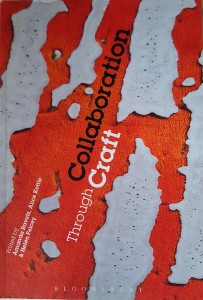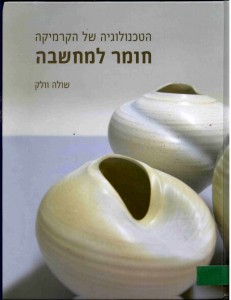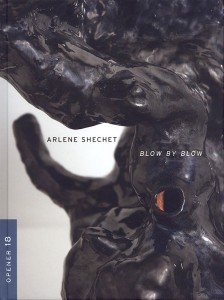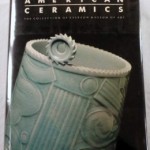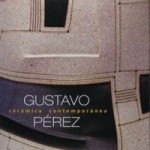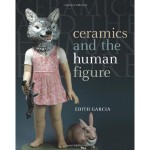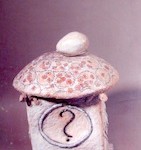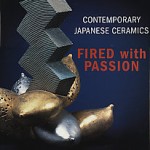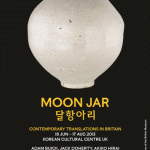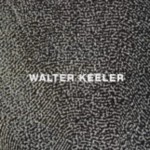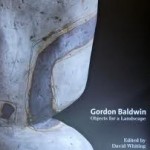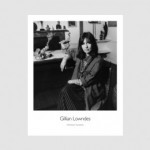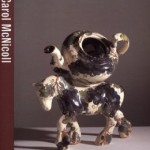NEWS FROM THE LIBRARY August 2018:
Piet(er) Stockmans: a Masterly Dilemma by Piet Stockmans
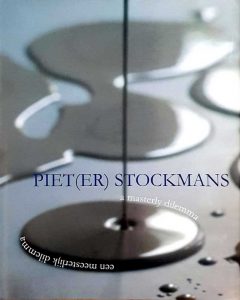
-“Piet Stockmans is one of the internationally most well-known veteran porcelain artists and designers from Holland. He has been an industrial designer for major famous porcelain factories such as Selb in Germany and Royal Mosa in Maastricht and taught at the famous Design Academy in Eindhoven and Genk. Since 1989 he is a freelance porcelain designer and artist, known for his clean white designs with minor blue strokes, and mainly for his large porcelain installations, either in space or on walls, composed of multiple vessels or elements. His work has been widely exhibited around the world.”
The Complete Guide to Mid- Range Glazes: Glazing and Firing at Cones 4-7 by John Britt
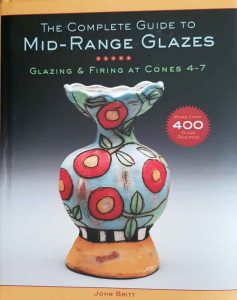
A book for ceramic artists that fire at mid-range between cone 4-7. The book includes recipes as well as clear information covering glaze tips, firing details and has many photographs to inspire those who are looking for special effects.
The Shape of Craft by Ezra Shales
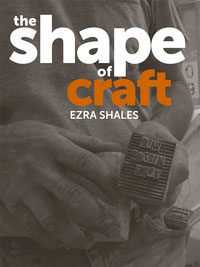
A book by Ezra Shales, professor of Art at the Massachusetts College of Art and Design: Shales specialized in theoretical thinking about the field of Craft. It is an inspiring book about the way things are made in this new hot field. Sheila Hicks in her comment on the book says: “Shales’s book sharpens our visual perception and appreciation of finely crafted objects and environments which have enriched our lives from the beginning of times”. And Theaster Gates’s comment completes: ” Steering the conversation towards anonymous artisans and the sort of craft that doesn’t usually end up on museum pedestals, Shales brings making back down to earth where it can connect to our cities and everyday lives.” It’s indeed a wonderful thought-provoking book with a broad array of cultural associations and ethnic and historical references.
NEWS FROM THE LIBRARY January 2018:
GLAZE | the ultimate ceramic artist’s guide to glaze and color
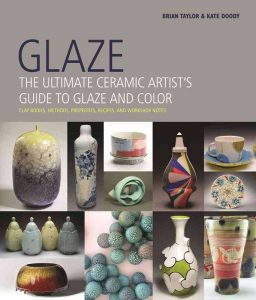
This very clear and well presented book on Glazes was published in 2014 by two American professors specializing in glaze research. Besides a clear and concise technological part, another chapter talks about COLOR with subjects like color harmonies, color effects and illusions, contrast. But the main part of the book is composed of artist pages of 100 chosen international artists to show different color approaches and how they relate to the specific work, explaining the method in detail.
CLAY: CONTEMPORARY CERAMIC ARTISANS
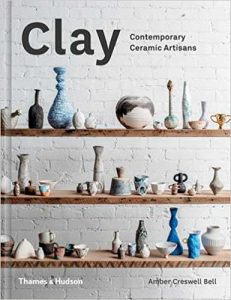
A trendy coffee table book from 2016 which is nicely presented and has something “democratic” about the choice of the 53 clay artists chosen for this volume. The Australian author chose makers from different countries, most unknown and often autodidacts, and often quite new to the field. It tells each one’s story of their discovery of and relationship to clay and shows photos of their work and some studio shots.
NEWS FROM THE LIBRARY December 2017:
This beautiful book from 2006 on the famous Danish Ceramic Artist Bodil Manz shows her life work of her well-known porcelain Cylinder shapes. Those very thin pieces are either cast in the normal casting process or sand cast. They are superbly decorated with unending variations of monochromatic geometric minimalist designs, on the surface of the piece as well as inside, showing through, thus creating a carefully planned dialogue between inside-outside.
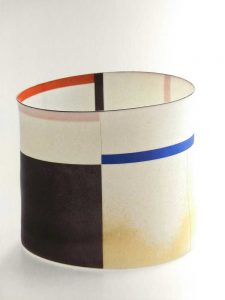
This book is fascinating on a few levels: first of all showing us the evolution of an artist who works in close partnership with her equally famous husband of many years, Richard Manz, on lines of ceramics for use, till establishing her independent and very recognizable and unique style. Furthermore there is a lengthy and very beautiful interview with Bodil about her unique partnership with her husband in the same studio, about the challenges of raising a family and combining it successfully with an intense career in ceramics, and of the importance for her of working with clay. The interview is one of the most sensitive, intuitive ,wise, unassuming and human I have read, with a lot of life sagesse, an uplifting read for any ceramist as well as any layman.
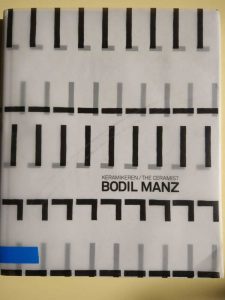
NEWS FROM THE LIBRARY January 2017:
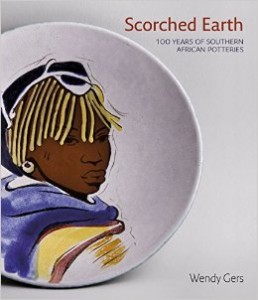
Scorched Earth: 100 Years of Southern African Pottery
The South African, France-based curator Wendy Gers published a book about the history of the ceramic industry in her native country, a first in this field. For 10 years she researched the subject in depth with the agenda of bringing back the awareness of this industry and craft, and the resulting objects, within the esthetic and artistic sphere in South Africa.
The book gives an in-depth, systematic, clear, historic overview of about 30 factories (Gers says she has material for a second book), and places this ceramic production within its political, social, and cultural context.
Gers tries to show and analyse the extent to which cross- influences existed between the white “colonialist” creators of British and Dutch extraction and the indigenous black creators, how their esthetics, if at all, conversed and got expressed. It is noticeable, when reading through the book, that the white hegemony with its visual tradition of shapes they brought with them dominated the field, even when black potters worked within the workshops. The local touch is very minor, and when existant, it gets expressed mainly in surface decorations like scenes typical of African life, a bit like on souvenirs. Only in very few cases, like for instance in the Thaba Bosigo workshop in Lesotho, initiated and run for quite a few years by British ceramic artist Peter Hayes (who demonstrated in Israel over 20 years ago), and in Rorke’s Drift in Kwa- Zulu Natal there is clear formal and decorative expression coming from Blacks themselves with their visual traditions. These two workshops were located each within a “homeland”, independent Black areas, and Rorke’s Drift was initiated and run by a social Church initiative for the Black community. It is very enlightening and interesting to read the interviews relating to that undertaking.
As an Israeli reader viewing the visual content of the book, I couldn’t not notice the esthetic similarity with items produced in Israel at the same time: in our local industry we too were nourished by the immigrant German and continental European esthetic the European- trained ceramists brought with them, and by the clear cultural “European hegemony”. And here too the influence of the local was expressed by those immigrants in their conception of orientalistic decorative motives, often made to be given to foreigners. It is striking that most of the ceramic production Gers shows in her book could have been made anywhere at the time, a sort of global style without a clear local esthetic. And as in South Africa with the Black potters, also in Israel the pottery of the local Arab population had an independent parallel existence to the main “modern” ceramic industry.
NEWS FROM THE LIBRARY FEBRUARY 2016:
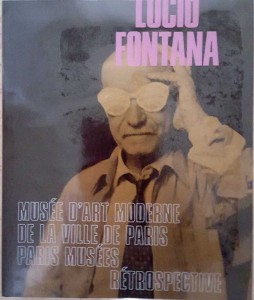
LUCIO FONTANA (Italian, 1899-1968)
on the work of Lucio Fontana, published for the big retrospective exhibition held in Paris in 2014. This retrospective shows in a prominent way the importance of Fontana’s ceramics.
Lucio Fontana, besides having been a groundbreaking artist and one of the greatest visionaries of the 20th century, working in many materials, and most known for his slashed canvases, has had a prolific and influential career as a ceramic sculptor.
Fontana’s glazed ceramics got a lot of attention and were greatly appreciated, especially in France, when he started making them in the 1930ies in Italy at the studio in Albisola at the Manufattura Mazzotti. They were groundbreaking in their wild abstraction and their wild polychrome surfaces, so different from the Picasso ceramics for instance. His are very physical, carnal, sensual and baroque, they have a raw immediacy, conveying the beauty of chance and accident. His was a vigurous hand-modelling, tactile expressionism, so that the clay would become the register of the artist’s process. Fontana made it very clear that he doesn’t know how to work on the wheel and never did: “I am a sculptor and not a ceramist… I loathe the mystification of technique”, needing to make this clear against the tendency of critics calling his sculptures “ceramics” at the time. For him form is never disassiociated from color. During his time at Sevres, he studied “form and the expression of form”, “…shapes echoed the rythms that formed inside me, wild, tumultuous rythms that had nothing to do with beauty.” Fontana said: ” Ceramics are the aristocracy of the art of sculpture”.
Fontana’s work in Ceramics is vast, from his intimate sized sculptures to friezes he did for buildings, working with famous architects of his time. This ceramic aspect of his work was long overlooked, after its haydays, and has now a big renaissance which gives it back the place Fontana intended it to have in his oevre.
(Ester Beck)
NEWS FROM THE LIBRARY NOVEMBER 2015:
The Library has now about 850 books, it is constantly being updated with the newest publications and with interesting older or historical material concerning ceramics from all over the world.
Here are some of our new acquisitions:
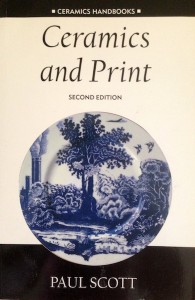
“CERAMICS AND PRINT“, author Paul Scott (2002): the book gives a rich how-to account of a large variety of printing techniques on ceramics, from traditional ones to those that use laser printers, computers, screen printing, lithographic printing and direct photographic methods.
Here are some new books on material theory:
“COLLABORATION THROUGH CRAFT“,(2013): the result of an international conference held in 2011 on that very contemporary subject at Manchester Metropolitan University with leading practitioners and theoreticians in the field. This volume discusses this new approach to making as a social, cross-cultural, cross-disciplinary discourse which surpasses the individual-oriented studio practice with its intra intra-disciplinary concerns. It discusses the pro and cons, the difficulties one encounters and the multiple benefits arising from opening up to a more inclusive practice and exchange.
“MATERIAL THOUGHTS“, David Bramston, (2009): this is a book for product designers working in different materials, describing different materials and processes and experimental approaches, encouraging challenging conventions through curiosity and experimentation, and promoting physical enquiry into materials.
“SEEING THINGS– collected writing on art, craft and design”, Alison Britton (2013): Britton is an important British Ceramic Artist and a critical writer as well. This collection of well written articles, critiques and responses she wrote for different venues, presents us with a broad spectrum of discussion on the essence, boundaries and the place of the ceramics in relation to art and design.
A FEW NEW ALBUMS:
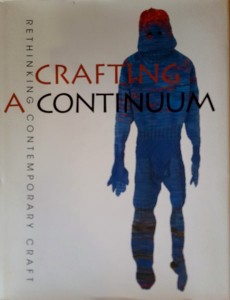
“CRAFTING A CONTINUUM: rethinking contemporary craft” (Peter Held, 2015): this volume brings a first overview of Arizona State University’s internationally renowned contemporary crafts collection, emphasizing ceramics, wood and fiber.
“ARTS/INDUSTRY: collaboration and revelation” (2014): this beautiful volume gives a visual history of this extraordinary John Michael Kohler Arts Center located in Wisconsin, which was founded in 1974 in collaboration with the industrial firm Kohler Co., thus providing artists with the possibility of using the industrial premises dealing with ceramics and with metal for their work done in residency programs there. The catalog shows us in beautiful images the projects done over the years by many well-known ceramic artists, and gives us a written insight in the workings of such a center.
“BRICK” (Dan Cruickshank, 2015): this is a rich and beautiful volume on the history if brick construction all over the world. It hails this oldest of fired materials with its aesthetic, economic, environmental, structural qualities, and shows its esthetic and ecologal relevance in our times.
And as always, we get the newest Ceramic Magazines from all over the world:
Just some latest samples:
COME FOR A GOOD AND UP-TO-DATE READ AT THE Benyamini Library and come away with new insights and ideas!
News from the Library – August 2015
Large Donation of ceramic books received from the Collector David Glick
We have the very good fortune to receive part of the extensive library of the ceramic collector David Glick who has a world renowned collection of chawans (tea bowls). The books cover his special interests including Japanese and Chinese ceramics and especially tea bowls. Many of the books are about traditional ceramics in the USA and England and there are auction catalogs from Sotheby and Christies from the 20th Century. Many of the books are collector’s items and without Davids systematic and in depth research we certainly would not be exposed to these items. We express our deep gratitude to David for his generosity.
New Books in the library
[nggallery id=301]
“Means of Production: Richard Slee 2003-2014”:
Richard Slee is a leading ceramic artist in Britain who creates work based on everyday objects common in the local culture with a shiny, pop art finish.
Technical books including –
- The New Ceramics: Additions to Clay Bodies:
- “The New Ceramics: Sculpting and Handbuilding”
- Dry Glazes
FIRING: Philosophies within Contemporary Ceramic Practice
A book by David Jones that covers an interesting perspective of this inherent part of ceramic practice. The titles of the chapters give a hint to the view taken by the author.
“The Chemistry of Combustion”, “20th Century background to firing in the West”, Eating, drinking, cooking, firing”, “Firing as metaphor”, “Denial of fire”
An important comment from Ester Beck the director of our library:
The library was established and continues to grow without funding from outside and is based on donations. It is our aspiration to have a broad, rich and up to date library. We have noticed that several of the books have been removed from the library, a fact that is extremely frustrating for the Benyamini team. We ask that all users and visitors to the library respect our efforts to have our library available for the convenience and enjoyment of everyone and use the books in the center only.
We have available a scanner that can be used to copy any material of interest.
Thank you for your cooperation.
News from the Library – March 2015
The Library keeps constantly growing and being updated. We invite you to keep yourself informed by visiting the Database of the Library in the Bet Benyamini site. We also invite you to consult the rich Library on site at the center. The many international magazines we get keep us informed about the state of ceramics in the world, artists, trends, events.
[nggallery id=273]
Here are some vignettes from the latest editions:
- The English magazine “Craft” published an article on the newest work of the well-known British ceramic artist Kate Mallone: it describes her newest project of a ceramic tiled full-front wall of an office building, for which Mallone created big tiles with crystalline glazes. It also talks about her activities in projects for the public. These creations take Mallone out of her usual studio work where she creates over the years her vessels inspired by nature. In this domain we also see her new more geometric-playful direction in her newest “vases”.
- The French magazine exposes an exciting Austrian artist, Elmar Trenkwalder: Elmar creates big baroque sculptures which were executed during his residency at the famous “Sevres” Factory in Paris. His stunning innovative sculptures have something grandiose, their figurative compositions, glazed with strong monochrome glazes, remind of baroque church elements.
- We got the book “Herend- The art of Hungarian porcelain” which shows the production of this famous factory, the Hungarian equivalent of the German “Meissen“. Herend porcelain is very known for its wonderful qualities, on the level of “Limoges” which we are more familiar with, outstanding for wheelwork and hand forming. I was exposed to this local Hungarian clay during a residency at the famous International Ceramics Center in Keczkemet, a great place to work with this clay.
We got a number of new foreign artist’ catalogs of well-known artists:
- “Calligraphy in Clay” with the works of recent years of the French artist Jean-Francois Fouilhoux: his work, in celadon porcelain, is like a variety of spontaneous brushstrokes standing lightly and ethereally in space, an amazing feat.
- Also in porcelain: the provocative sculptures of the Hungarian artist Laszlo Fekete are compositions with porcelain figurine elements reminiscent of Middle-European Salon esthetics. Through those works, typical for Fekete, he makes in his sarcastic provocative manner historical- social critical comments.
- And from Germany: the works of the Halle artist Renee Reichenbach, geometric architectural constructions with interesting graphic design surfaces. It is of interest to notice in each of the artists the imprint of the specific environmental cultural and visual field in which each creates, some kind of a “national” feel.
What’s new in the Library November 2014:
[nggallery id=259]
Many new books keep arriving, as well as DVDs:
Grainer Collection
Contemporary British Studio Ceramics is the excellent Grainer Collection book published in 2011. It contains the best British Ceramists of the last decades.
Blue and White Delft
Is the well designed catalog which accompanied the exhibition by the same name , held at the Tel-Aviv Museum in 2014. The exhibition showed examples of old Delftware, tiles and pots, as well as work by contemporary Israeli Artists who were inspired in their own work by this iconic style of blue and white.
11 DVDs
We received 11 DVDs of demonstrations by different international as well as local artists who participated at the Irish Symposia of Ceramics between 2006 and 2012. Among them the Mexican Rafa Perez, the British Walter Keeler and the French Daphne Corregan, and Tip Toland, the American figurative sculptor who demonstrated recently at the Tel-Hai Ceramics Symposium, and others.
We keep looking:
Also for more unusual and esoteric material, like the beautiful catalogs of the Jason Jacques Gallery of New York who specialize in turn-of-the –century French Pottery, as well as in contemporary international artists. Here are two examples, one of French Art-Nouveau Lustre pottery, and one of a contemporary artist who does Trompe-wood ceramics :
We regularly receive all the International magazines. These are the most recent ones:
Ceramic Art and Perception
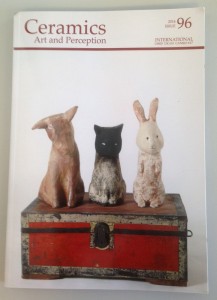
La revue de la ceramique et du verre
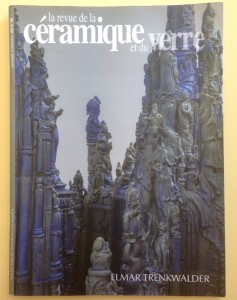
We invite you
To continue using our Library on the premises of Bet-Benyamini. Unfortunately we cannot lend any of the material to be taken out, but we hope you continue enjoying the library as a source of inspiration. Please consult the Database which will show you everything we have.
New acquisitions at the Library (April 2014)
Among the different news books, let’s mention a few here…
“Gefaess/Skulptur- Vessel Sculpture”:
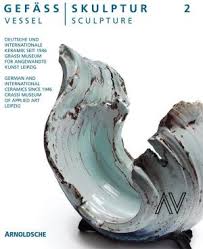 This beautiful album shows the extensive and comprehensive Ceramics collection of the Grassi Museum of Applied Arts in Leipzig, Germany, from 1946 till today, comprising thousands of item . This is the second volume published so far, showing a selection of the whole collection, mostly German, French, English and Scandinavian artists. It is a superb and somewhat austere collection, reflecting their origins from the donations of important collections of German Collectors. The Grassi Museum is today one of the important Museums in its field. Till 1989 it was behind the Iron Curtain and had only East-German Ceramics, and in the late 1990`s outstanding collections were donated and this trend is ongoing, showing the important position this institution assumes today.
This beautiful album shows the extensive and comprehensive Ceramics collection of the Grassi Museum of Applied Arts in Leipzig, Germany, from 1946 till today, comprising thousands of item . This is the second volume published so far, showing a selection of the whole collection, mostly German, French, English and Scandinavian artists. It is a superb and somewhat austere collection, reflecting their origins from the donations of important collections of German Collectors. The Grassi Museum is today one of the important Museums in its field. Till 1989 it was behind the Iron Curtain and had only East-German Ceramics, and in the late 1990`s outstanding collections were donated and this trend is ongoing, showing the important position this institution assumes today.
“Gareth Mason: Other forces”:
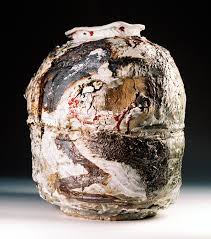 This is a small thrilling catalog with the unusual surfaced ceramic vessels of this daring artist who a few years ago was a guest demonstrator at our annual Tel-Hai Ceramics Symposium. His specialty lies in his inventive multiglazed surfaces, onto which he sticks all kinds of ceramics pieces, remains from other pots or pieces fallen off during the making process, all creating a wonderfully wild and unique occurrence. This exhibition was in the Jason Jacques Gallery in New-York.
This is a small thrilling catalog with the unusual surfaced ceramic vessels of this daring artist who a few years ago was a guest demonstrator at our annual Tel-Hai Ceramics Symposium. His specialty lies in his inventive multiglazed surfaces, onto which he sticks all kinds of ceramics pieces, remains from other pots or pieces fallen off during the making process, all creating a wonderfully wild and unique occurrence. This exhibition was in the Jason Jacques Gallery in New-York.
Another catalog in our Library which shows his work is “Moonjar”, from a beautiful group exhibition which took place last year in London.
“Horror Vacui: Morten Loebner Espersen:
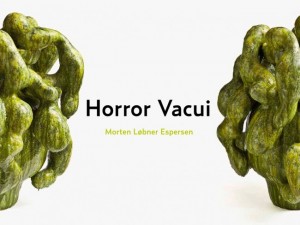 This interesting internationally renowned Danish ceramist’s catalog of a 2012 shows us an expert of the richly multi-glazed surfaces on very stern iconic cylinders, as well as on abstract sculptures. The Scandinavian understatement is counterbalanced with an exuberance of and research into these rich and deep surfaces, little known in our parts, true also for Mason’s work.
This interesting internationally renowned Danish ceramist’s catalog of a 2012 shows us an expert of the richly multi-glazed surfaces on very stern iconic cylinders, as well as on abstract sculptures. The Scandinavian understatement is counterbalanced with an exuberance of and research into these rich and deep surfaces, little known in our parts, true also for Mason’s work.
“Clement Massier, master of Iridenscence”:
 Massier (1844-1917) was an important and innovative ceramist of the Art Nouveau period in France. His specialty was his vases and platters inspired by the ceramics of Japan, Persia, the Near East, and his glazes and decorations researched the famous lusters of those cultures. He reached a stunning depth in his surfaces and a flow in the decoration thereon which made him unique among the other famous French ceramists of the period. It is exciting and informative to go back in history to see the heights reached here.
Massier (1844-1917) was an important and innovative ceramist of the Art Nouveau period in France. His specialty was his vases and platters inspired by the ceramics of Japan, Persia, the Near East, and his glazes and decorations researched the famous lusters of those cultures. He reached a stunning depth in his surfaces and a flow in the decoration thereon which made him unique among the other famous French ceramists of the period. It is exciting and informative to go back in history to see the heights reached here.
These are three different examples of ceramists over time who all invested their research into the richness endowed to the surfaces of their vessels.
Library news: December 2013
A newly published book by Shula Wolk on Ceramics Technology
The great news is that this is the first book in a long time on the subject in Hebrew, long awaited by Israeli ceramists. Shula is a teacher of ceramics, focusing on technology, and an in-depth investigator into the mysteries, the physical and chemical underpinnings and possibilities in glaze development.
Catalogue – “Blow by Blow” by Arlene Shechet
Arlene Shechet is an exciting abstract expressionist sculptress who adopted clay as the medium most suited to her creations of the past 10 years. An in-depth article can be viewed in the Benyamini center blog.
Library news: September 2013
The book AMERICAN CERAMICS: THE COLLECTION OF EVERSON MUSEUM OF ART is a wonderful collection of American Ceramics from its historical beginnings on the continent through till the late 20th century, accompanied with thourough articles on each period, for example Garth Clark’s article “American Ceramics from 1950”. The collection carries the most important representatives of the 20th century american ceramic artists, a valuable historical document.
GUSTAVO PEREZ: CERAMICA CONTEMPORANEA edited by Artes De Mexico (in English and Spanish) is a monograph on the most important contemporary mexican ceramic artist who has long been exhibited and collected in Europe and America, showing in the most important ceramics galleries. Perez developed a particular individual style of vessel making and decorating through a method of cutting patterns (reminiscent of Lucio Fontana) into the surface and thus creating a very particular language of decoration, drawing on the traditional mexican ceramics and taking it to a unique modern expression.
CERAMICS AND THE HUMAN FIGURE by Edith Garcia is a recently published overview of the contemporary field of figurative sculptural ceramics, showcasing the work of a large selection of diverse artists with their unique styles and techniques. The artists are listed in interesting categories, for instance “Gender and social issues”, ” Hybrids”, “Disappearance”, and ” The human condition and everyday life”. The book is accompanied by a very well-analyzed article by Dr. Bonny Kemske (editor of CERAMICS REVIEW and ceramist listed in the book as well), putting the different modes of figurative expression into a cultural and ideological context. This book, as others like Judy Schwartz’s CONFRONTATIONAL CERAMICS, is especially interesting in our local creative field where ceramic sculptors are still relatively rare, and where this field has not yet found its potential of expression.
BIANKA ESHEL-GERSHUNI: STEP BY STEP: is the beautiful Tel-Aviv Museum exhibition catalog of this interesting and puzzling artist. Although not a creator in Clay, but in papier-mache’, her language has relevance to ceramic artists as well, since Bianka expresses her ideas often through a vessel-like form, and since the material used could as well been taken for clay. Often clay tries to imitate other materials, here we have a kind of unintended reversal of roles, seen from a ceramist’s point of view. We have in our Library a section for ART and also for CRAFT: while Bianka uses a craft-medium for her art, she is definitely an artist belonging to the ART category; but this issue shows the contemporary expansion of inclusion of materials used by the visual artist, where unfortunately artists working uniquely in clay still find themselves fighting for their standing as artists and acceptance into museums as such.
FIRED WITH PASSION: CONTEMPORARY JAPANESE CERAMICS: this book showcases a choice of top contemporary Japanese ceramic artists- sculptors which are represented by the DAI ICHI Ceramics Gallery in New-York, who are as well the editors of this collection. Artists like Nakashima Harumi, Takauchi Shugo, Suzuki Goro and Higashida Shigemasa, are among some of them. The book gives a short historical introduction to the different important periods in Japanese ceramics, introduces the pioneers of Abstract Ceramic sculpture from the 1950ies on, and devides the contemporary artists into the different geographical regions where they work. It is a very rich book with excellent photographs and a brillinat choice of pieces.
MOONJAR: This little catalog is a little pearl that accompanied the beautiful exhibition held in London in the summer 2013 around the famous korean MOONJAR – a big round white-glazed pristine porcelain vase which reminds the moon and is venerated as a korean classic. The Moonjar exhibited here was brought back by Bernard Leach from his travels to Korea, and for this show 5 British ceramic artists were invited to show pieces which relate to this iconic piece: Adam Buick, Jack Dogherty, Akiko Hirai, Gareth Mason and Yee Sookyung, a beautiful range of interpretations which could not have been better chosen. The show was accompanied by a beautiful specially made short film by James Kelly which we just received at the Benyamini Library.
We have just acquired some new monographs/books on some of the most important contemporary British Ceramic Artists:
WALTER KEELER: is one of the best-known English vessel-makers. His teapots, jugs, and casseroles all are functional, salt-fired and with their typical surface, imbued with a carefully constructed architectural look which makes them precious. “Wally” has always been an innovator and come into his own recognizable language by 1980, thus breaking with traditional English pottery and the Leach and Cardew tradition which informed still most of the potters then: his work is meticulously constructed, inspired by tinware with their typical spouts and handles; he transposed the language of those shapes and “additions” into his unique vessels recognizable by their appendixes who enrich the basic cylinder forms.
GORDON BALDWIN: OBJECTS FOR A LANDSCAPE: edited by David Whiting is a beautiful long-verdue document on this important living British abstract ceramic sculptor, active since the 1950ies. The gallerist and writer Garth Clark coined the term “Organic Abstraction” referring to Baldwin’s amorphic bodies with their dry surfaces and very subtle surface drawings. Baldwin created a unique style and became a leading influence on younger ceramists breaking away from the narrow Leach tradition. Baldwin’s inspiration was landscape, music by John Cage, Steve Reich and John Adams, artists like Arp and Duchamps. “His art is about the relationship between inner and outer space, the smoother, often quite muted deviations of structure and the many-layered depths of the glazed clay”. His language is “intensely reflective and consolidated” (David Whiting). His work is in all the major collections.
GILLIAN LOWNDES: this long-overdue and only existing monograph on this British artist, edited by Amanda Fielding in 2013, after many years of work (and published posthumously for both artist and editor) honors finally this very important contemporary ceramic artist who dared take the medium out of any conventional norm known. She experimented with firing abstract rather ethereal objects made of different clays and various found materials, an artistic approach to be compared to artist Eva Hesse in her research of using the found object like the process artist. Lowndes was very attracted to the work of the americans Ron Nagle, Ken Price, Richard Shaw, and the japanese Nishimura Yohei, and in later years her inspiration came from african art as well as finding affinity with Andy Goldworthy, David Nash and David Mach. She is part of the modern movement in British ceramics which included Gordon Baldwin, Ruth Duckworth, Dan Arbeid, and Ian Auld, all related to the CENTRAL SCHOOL’s pottery department in London which in the 50ies made the most important statements in the history of 20th century ceramics, together with America’s Abstract Expressionist movement. Teaching at Camberwell school of Arts, she was in one group with the innovating ceramists Ewen Henderson, Carol McNicoll, Colin Pearson and Janice Tchalenko. It has always been difficult to find a clear definition of where to place Lowndes’ very abstract and idiosynchratic art, different from anybody else’s in the medium. Her work has always been very thought-after collectors items and she is represented in the most important museal and private collections.
CAROLL MC NICOLL: this again only book on this interesting British ceramic artist (published by the “Contemporary Crafts Series which took it upon itself to publish books on the main craft artist of Britain) was written by the craft writer Tanya Harrod and the curator RoseLee Goldberg who gave Caroll her first show and was a champion of her work. On the cover of the book it says: “McNicoll’s objects embody quintessential English eccentricity….yet all are functional: a characteristic that illustrates McNicoll’s determination to push back boundaries and to make everyday objects extraordinary. This preoccupation with the unexpected is reflected in the artist’s favoured technique, slip casting, primarily and industrial process whose association with replication and mass production is intrinsic in her work.” McNicoll occupies a slight outsider position in the ceramics field, expecially when she was the only one working in the way she did. ” She is one of a group of women artists such as Allison Britton, Jacqueline Poncelet and Jill Crawley who between them transformed the British ceramic scene” (Tanya Harrod). McNicoll was very influenced by the unusually open and experimental athmosphere at the Leed Polytechnic of the late 60ies, virulently anti studio pottery of the day, where she got her Art and Design degree. She was and is informed in her work by pop music, fashion, performance art and current social and cultural issues. Today she is clearly a prerunner of a long-accepted contemporary trend in ceramics.
April 2013: New books have arrived to our library!
Jun Kaneko: The book on one of the most famous american (japanese) ceramic artists today is a tremendous eye-opener on how far clay can be taken as a sculptural and painterly medium in one; Kaneko’s huge Dango sculptures with their exciting colorful graphic surfaces have a hypnotic power, and learning about his studio and working technique challenges us to a new dimension.
Another book, by Carolyn Genders, shows us interesting ways of bringing color into vessels. Carolyn visited Israel this winter and gave a workshop at Neot Hakikar, producing much enthusiasm among the participants who found her technique fascinating and useful.
[nggallery id=162]
The Benyamini Library has recently received some of the most recently released and state-of-the-arts books.
One example is the fabulous book “Shifting Paradigms in Contemporary Ceramics: the Garth Clark and Marc Del Vecchio Collection”, following the exhibition by the same name in 2012 at the Houston Museum of Fine Arts (and received from the curator of the museum, Cindi Strauss who visited the Benyamini Center). Clark and Del Vecchio have been for a long time one of the most world-renowned Ceramic Art Gallerists, based in the U.S., and their influence was and still is far-reaching in the field. They have built up a world-class collection which now found its first exposure to the general public, representing the best and finest of World Ceramic Art. Garth Clark has as well been one of the most prolific writers of critical articles on Ceramics and a big advocate of an art criticism applied to this specific field. His writings can also be found in the book “Shards: Garth Clark on Ceramics”, published in 2003, a compilation of his articles (also on our library shelves).
Critical writing
We are very conscious to add to the library books that deal with this subject and get our hands on anything written in this line. Today the ceramic medium has reached such heights of sophistication and richness that it cannot exist outside of the art discourse practice, and find its particular conceptual and critical language and expression fit for this medium. It has become one of the hottest issues in todays international ceramics discourse.
Along these lines, we received the book entitled “Utopic impulses: contemporary ceramics practice”: it is an anthology of essays, artist projects and images which envision new and stimulating conceptions of how studio ceramic practices contribute to improving the social and political fabric of our time.
Artist Monographs
We received the extraordianry book-catalog of “Ken Price: sculpture- a retrospective”, accompanying the posthumous exhibition of this uniquely original and influential american ceramic artist, held at the Los Angeles County Museum of Art in 2012. It shows the development of one of that strong Westcoast movement of ceramists, like Peter Voulkos and others, who revolutionized the understanding of ceramics from the 1960ies on, starting to break with tradition and accepted rules from the pottery tradition, introducing influences from the current art movements of the period and reinterpreting the ceramic object, whether through treatment of approach to clay, shape, meaning, or surface.
How to
Having an active school for studying the different ceramic methods at The Benyamini Center, we focus on books on ceramic technique. The latest addition is “Single Firing: The pros and cons”. This is just one of the many HOW-TO books in the Library of the many techniques through which to create a wide array of ceramic styles, from the different pottery techniques and styles to sculptural and design methods.
Enjoy this ceramic treasuretrove!
[nggallery id=155]

